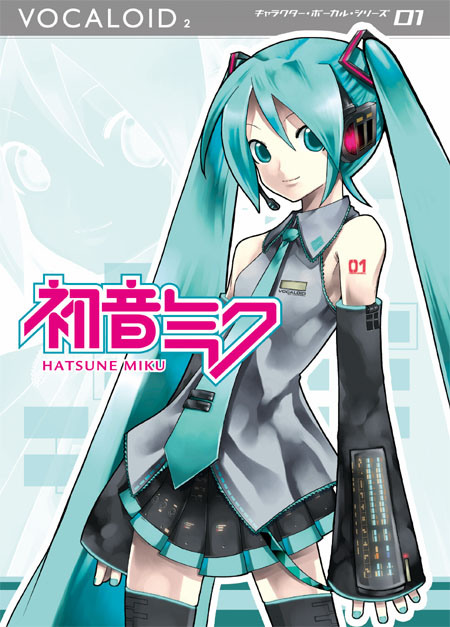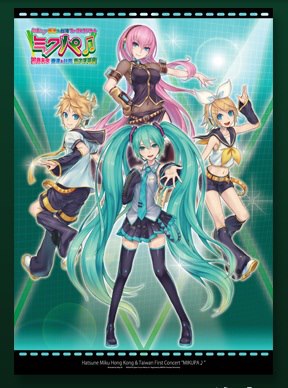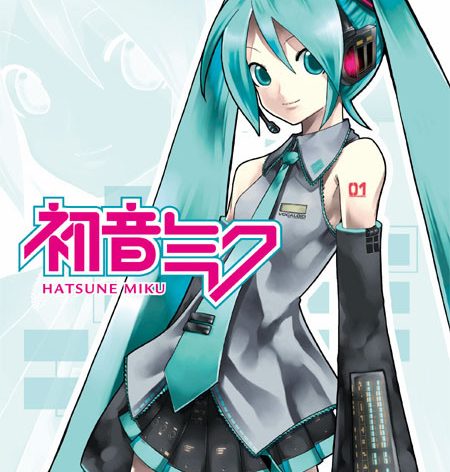What is a Vocaloid – A Look Into Our AI Autotuned Future
There’s a very good chance that if you are reading this, you have no idea who Hatsune Miku is and have never heard of a Vocaloid. However, there’s also a fantastic chance that if you are reading this, you’ve heard a Vocaloid sing and you’ve either thought it was awesome or incredibly annoying.
Have you heard or seen the Leek Spin? How about Nyan Cat?
Basically, if you’ve been on the internet, you’ve heard Miku (or one of her fellow Vocaloids). But who in the hell is Hatsune Miku and what in the world is a Vocaloid?
Originally released in 2004 by Yamaha, the Vocaloid engine is a singing voice synthesizer software. Using Yamaha’s engine, Crypton Future Media began releasing the widely known product we know as Vocaloid today as well  as eventually starting its own music label, KarenT, to distribute Vocaloid tunes. The first Crypton-released version of the software was represented by the character Meiko, who plays the role of the AI whose voice is being used to sing the songs created by the software user. Each of these iterations of Vocaloid have been represented by another character in the Japanese fashion of mascot characters being used to sell EVERYTHING (that’s for soy sauce, yo). The actual mundane HUMAN voices broken down into endlessly tweakable Vocaloid voice banks have even included Gackt, one of the best known J-rock idols in the history of incredibly attractive, incredibly androgynous guys in eyeliner.
as eventually starting its own music label, KarenT, to distribute Vocaloid tunes. The first Crypton-released version of the software was represented by the character Meiko, who plays the role of the AI whose voice is being used to sing the songs created by the software user. Each of these iterations of Vocaloid have been represented by another character in the Japanese fashion of mascot characters being used to sell EVERYTHING (that’s for soy sauce, yo). The actual mundane HUMAN voices broken down into endlessly tweakable Vocaloid voice banks have even included Gackt, one of the best known J-rock idols in the history of incredibly attractive, incredibly androgynous guys in eyeliner.
Vocaloid didn’t really gain a big following in Japan until Vocaloid 2 was released, starring the teal-haired Hatsune Miku (Miku Hatsune). She followed Meiko and Kaito (the first male Crypton Vocaloid), displaying a younger, higher voice than Meiko and a schoolgirl-ish costume. It was really the Leek Spin – Miku singing the popular Finnish folk-song “Ievan Polkka” laid over a flash animation of a character from the anime Bleach spinning a leek for no easily understood reason – that kicked off Vocaloid’s popularity. Following Miku’s splash came Kagamine Len and Rin, a male and female vocal pack and a pair of characters best described as twins – though Crypton described them as ‘”one soul between the two of them” (so yeah). Meiko, Kaito, Miku, Rin and Len form the core of the Vocaloid family, though the franchise has massively expanded to include popular characters such as Megurine Luka (the first bilingual Vocaloid), Gumi, the aforementioned Gakupo (or Gacktpoid) and about 40 other commercially produced voice banks. There’s also been a huge surge of fan-created Vocaloids, called UTAUs.
Many of the popular Vocaloids have been released as V2.0 and/or Append, which might include ‘Sweet,’ ‘Dark,’ and ‘Vivid’ tones, smooth out the early, unnatural auto-tuned sound or even (like Kaito’s recent 2.0 3.0 release) include English voice banks. There’s also been a series of video games for the PSP, PSP Vita and PS3 called Project Diva, which are excellent rhythm games featuring some of the most well known Vocaloid songs; the player taps a series of button combos while the song plays a lovely music video featuring your favorite Vocaloids.
Vocaloid’s enduring popularity has been to present itself less as software and more as a platform for AI pop idols. Crypton does not give Vocaloids specific personalities – they’ve actually noted time and time again that Vocaloids serve as a base for their “owner’s” imagination (you’re welcome, 4chan!). Most unique habits and personalities for Vocaloids come from funny or cute aspects embraced by a very involved fanbase. This fanbase shares videos on sites like NicoNicoDouga, fanart on Pixiv and dojinshi manga on 2ch and at Comiket and other conventions.
Miku and her friends have even become popular enough to spawn live concerts. These are made possible by the fact that WE LIVE IN THE FUTURE. Thanks to AWESOME TECHNOLOGY (seriously, living in the future here), extremely realistic and gorgeously animated faux-3D holograms images are projected onto the stage alongside a live band of guys who are also probably pretty impressed by the GLORIOUS FUTURE. Concerts have mostly been in Asia, but there’s been a few staged at California anime conventions. Hugely popular, the crowds at the Vocaloid concerts create a sea of glowing leek-shaped glowsticks.
The actual music created by Vocaloid users varies widely, though a great deal of it is J-pop. Aside from the Ievan Polkka, the most well known instance of Vocaloid-produced AI autotune is prguitarman’s Nyan Cat. Yes, that voice you’ve heard say ‘nyan’ a few million times is Miku’s (actually Momo, who is an UTAU covering an original Miku song, “Nyanyanyanyanyanyanya!”). And of course, there’s sometimes awkward attempts at Vocaloids singing in English – made, thankfully, much easier now by the release of English voice banks, such as Kaito’s recent release or the long-anticipated Miku voice bank to be released this summer.
While the music created by Vocaloid might not to be every nerd’s taste (Once I tortured my roomates simply by playing this on repeat), the phenomena created by a few savvy companies and an excited fanbase is a great representation of what’s RIGHT with the internet and fandom. Recently, SEGA has been looking to gauge interest in a North American release (finally!) – by FACEBOOK, of all places. The positive word of mouth and excitement of the fans might very well make this a glorious victory for our adorable android music makers.
In parting, I’ll leave you with some great starting tracks if you’re interested in creating a library of great Vocaloid music.
[youtube http://youtu.be/g1Dqb6uJ8WY]
“Love is War” – one of the biggest hits, this is an iconic Miku video and has been covered by pretty much every Vocaloid in existence.
[youtube http://youtu.be/A3hGB-0ZHxE]
A delicious remix of the very popular song “Cendrillo,” a duet between Kaito and Miku (not that I ship them or anything I’m not a fangirl SHUT UP).
[youtube http://youtu.be/-dd4HqNOA4U]
“Double Lariat” – insert the sound of crying here. One of my favorite Vocaloid songs and probably one of the saddest. This video is from one of the live Vocaloid concerts and demonstrates how gorgeous this technology looks. This concert was 3 years ago – it’s only gotten better since.
And finally, my favorite Vocaloid song and another great concert video (and an terrible translation).
[youtube http://youtu.be/-ZwDhnCpDbs]
(This article was updated to correct some small errors and mis-wording pointed out from the very informative comments section!)






Thank you very much for the pingback to Mikufan.com. A very nice article on the subject, but with a few small errors to be noted:
Kaito was not the first Male Vocaloid, unless you’re counting only product releases by Crypton. The Vocaloid “Leon” predates Kaito by two years with a 2004 release. Kaito’s recent updated release was V3, not V2.
The word “hologram” is used quite often, since it’s the most easily understood term. But this is actually incorrect, as it’s simply a projected image onto a surface (like a piece of mesh or glass). It’s not actually in 3D, and not too different from watching a projected movie in a theater. The projection-on-glass trick has been used at Disneyland’s Haunted House ride since 1969. Of course, the projectors used today are more powerful, but the overall concept is still the same.
“AI” means “artificial intelligence”, and Vocaloid is in absolutely no way an AI. It’s a music program that cannot operate, much less think, without any form of user input.
The voice heard in Nyan Cat is actually the UTAUloid named Momo. However, Nyan Cat is a UTAU remake of another highly popular song/meme that DID use Miku: “Nyanyanyanyanyanyanya!”, composed by DaniwellP (song here: http://vocadb.net/S/123). You will find that “Nyanyanyanyanyanyanya!” predates the existence of Nyan Cat by 9 months, and had sparked its own wave of memes on nicovideo and youtube, eventually leading to the creation of Nyan Cat. I have written a short but detailed biography of DaniwellP: http://www.mikufan.com/?p=2740
Thank you for reading the article and leaving some feedback! I corrected the errors and mis-wording you’ve pointed out.
I use ‘AI’ (and ‘autotune,’ for that matter) more as a joke term than referring to Vocaloid being an actual AI program; mostly I’m riffing off of how many fan creations (from fanart to songs like ‘The Disappearance of Hatsune Miku’) portray Vocaloids as AI-like creatures or androids.
Thanks again for reading!
Cool post.